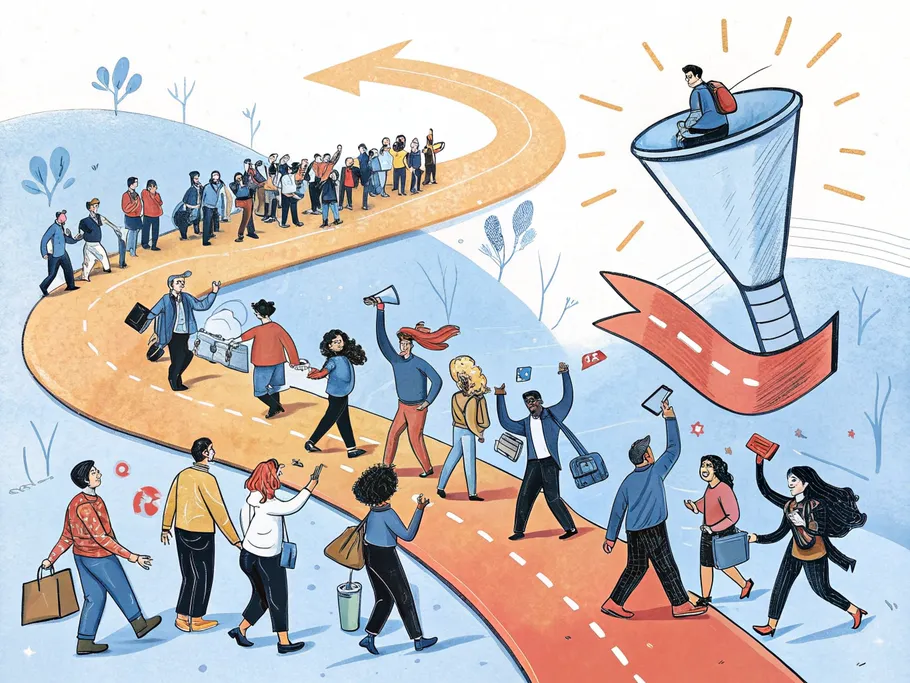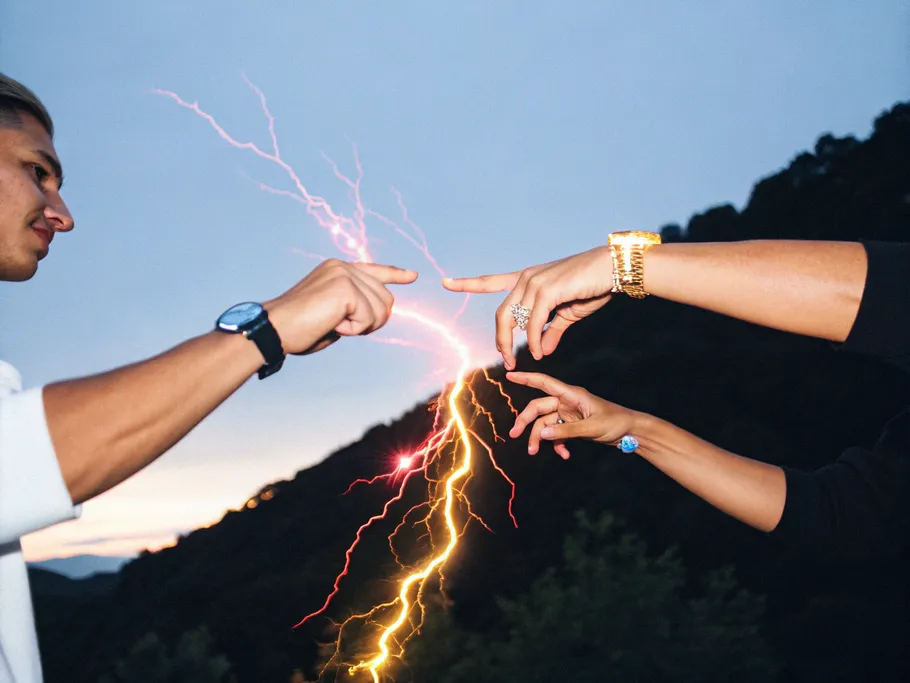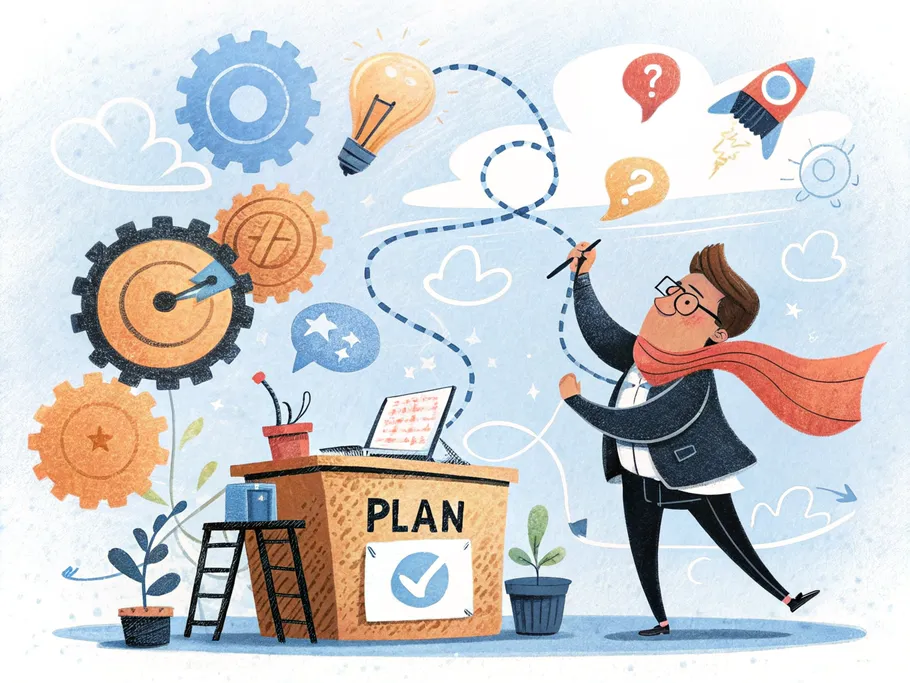Small businesses, in their infinite wisdom, prefer to light money on fire with ‘marketing’ – usually by copying the last desperate thing they saw – then wonder why nothing ‘sticks.’
Turns out, customers aren’t brain-dead automatons.
Real growth starts with understanding how people make buying decisions, mapping your funnel to match that journey, and allocating your resources accordingly.

So here’s your ‘guide’ to the obvious: understand how people buy, map your ‘funnel’ – because everything needs a fancy name – and try not to blow your budget on another useless ad.
In other words, you’ll get three essential concepts: the buyer decision process, the marketing funnel, and smart budgeting for small businesses.
Before we talk about ads, funnels, or even your offer… let’s understand what’s happening in your buyer’s mind.
How does a typical buyer make decisions? What are their thoughts like (in minute detail)?
Every purchase decision follows a PREDICTABLE psychological process.
If you’re able to tap into (and understand) how people think and make decisions, you’ll be able to ‘interject’ this thinking – and position yourself for success.
Here’s how that ‘let me buy something’ conversation usually goes…
Before I tell you, I’ll just make you an irresistible offer really quickly.
For just $0, you can get my Startup Launch Roadmap, where you’ll learn everything you need to know to build your product, launch it, attract some investors, and scale up to the moon.
This is the moment your potential customer realizes they have a problem or desire that needs solving.
They may not fully understand it yet, but something feels off.
Their business isn’t growing. Their website isn’t converting. They’re working too hard for too little return.
Your job at this stage isn’t to sell.
It’s to agitate the problem.
Create content that helps them name their pain. Use storytelling, relatable examples, and data to paint a picture of the problem they might be ignoring. Make it real.
I wouldn’t go for people who aren’t even aware they have a problem – but people who are in the ‘problem recognition’ phase can often be sold.
Once the problem is recognized, the buyer starts looking for solutions.
(Is it just me, or is this article starting to sound like a National Geographic Channel episode? The wild buyer starts looking for solutions… not knowing how vulnerable it is…)
This is when they begin Googling, asking for recommendations, binging YouTube videos, or scanning Reddit threads.

If you DON’T show up during this phase, you’re already losing.
You need to be present with valuable, educational content that positions you as the trusted guide.
In 2025, the best educational content you can make is full guides. The longer someone watches or reads something from you, the more they trust you.
Think of it like this:
Every minute someone interacts with your content gives you 1 standard unit of ‘relationship capital’. More minutes = more units.
The game is not about going viral anymore. It’s those pages with 2k followers and 39 minute full guides that make a TON of money.
Why do you think I write long-form blogs?
Now the buyer is comparing.
They’ve got options.
They’re weighing the pros and cons of working with you versus someone else. This is where most small businesses lose the deal, because they blend in.
To stand out, your offer needs to be designed intentionally. Not just a service list, but a true transformation. I already made an article about the characteristics of services you need to skyrocket your business, but here they go again:
When you check these boxes, you make their decision easier. Feel free to read the other article in full after you read this one.
HELL YEAH!
The customer bought your product or service.
But they’re still asking: “Will this work for me?”
This is where your onboarding experience matters more than your marketing.
If your proposal feels complicated, if your checkout flow is clunky, or if your terms create hesitation, you lose momentum.
Focus on these two things:
If you think your job is done as soon as you make a sale… nope.
Now they’re evaluating the decision. Was it worth it? Did it live up to expectations? Will they tell others?
Deliver early wins.
And once they experience success, ask for the testimonial, the referral, the review – don’t be shy about this. When you deliver great results, people are usually more than happy to help you out in return.
Happy clients don’t just bring in revenue. They become marketing assets.
Your buyer’s decision process naturally maps onto your marketing funnel. But too many businesses treat their funnel as a list of tools instead of a carefully designed system.
Here’s how this upside-down cone works:
Buyer Mindset: “I have a pain in my life that I want to solve.”
In your marketing, just grab their attention by pointing to the specific problem they’re feeling.
Literally make a document where you talk about ONE person… and map out ALL of their pains.
Then, simply talk about these pain points online. Help your customers resolve these pain points.
You really want to make people think: “Oh, this is me!”
When they can relate to your content, you get more trust. Also, think of talking about their pains like going to the doctor.
When your doctor presses on a painful point and says “I know exactly what’s going on here”, you’re VERY happy he made you feel some pain.
If he knows why you’re in pain, he must also know the answer, right?
That’s how your customers feel too!
Buyer Mindset: “I’m researching how to solve this.”
This is when people watch countless free tutorials online.
Again, think back to the ‘trust capital’ I talked about earlier. Let me dive a little deeper though.
In your long-form content, you want to do certain things, so that 1 minute leads to 2 ‘standard units of trust’.
When you share case studies, you get a TON of trust. People who actually invest in themselves care about this stuff.
If you share a proof element at the start of a marketing piece, everything after will be looked at with a different lens.
You’ll get more authority in anything you say.
Really make sure to document every single win you get.
Then, just spam it in your marketing. Truly. The more the merrier.
Buyer Mindset: “I want help, but I need to be sure.”
Your Job: This is where your offer does the heavy lifting. You need an outcome-driven, productized service that screams confidence and clarity. Add a bold risk reversal and a clear call to action.
Buyer Mindset: “Oh shit I’m doing this.”

Make it as FRICTIONLESS as possible. Have every single payment option available. Does someone want to pay by sending you 52 goats?
Perfect, here’s the link.
Don’t make users jump through hoops to become customers. Here are some more bullets of advice:
Your Call-To-Actions (CTAs) should clearly tell the reader what you want them to do. Use contrasting colors to make it stand out.
Buyer Mindset: “This was great. Who else should know?”
If you can delight your customer, you’re THAT more likely to get a referral. I’m not just talking about your delivery here.
Imagine you’re in a 1950 marketing agency for a second. They’re taking clients to dinners, buying them expensive cigars and champagne, offering them their wives…
Okay, no need to do the last part.
There was a lot of courtship at that time. We’ve kind of lost that, but it STILL works.
After a project, send your customers stuff. If you have 1000 customers, obviously don’t send expensive champagne to everyone.
Be appropriate. Discounts, loyalty cards.
But for high ticket clients, do go as far as to send physical gifts and handwritten notes. Nobody does that anymore, but it definitely works.

Let’s kill the myth that marketing is about big budgets, eh?
Marketing is about CLEAR bets.
And if you’re not confident in what you’re offering, no amount of money will fix that.
Here’s how to approach your marketing budget depending on your stage:
If you’re just starting, your budget should be focused on getting clarity and traction.
I’d say: forget the paid ads.
All your efforts should be on finding your product-market fit.
You can scale up and start spending more when you KNOW what works. Right now, your highest ROI activity is conversation.
Suggested Split:
This split helps you get optimal speed AND insight in your market. That’s precisely what you need in the early stage.
Once you’re getting referrals, repeat buyers, or consistent inbound leads – you’re entering the growth stage. Now it’s time to amplify your efforts and re-invest.
No worries, I have an easy rule once again.
Use the 70/20/10 rule:
At this stage, start delegating delivery. Your time is better spent refining strategy, systems, and scaling levers.
You’re a founde, not a freelancer!
It takes a bit of time to come here, but it’s well worth it.
Here, you shift from founder-led marketing to team-led execution.
Your focus is optimizing the unit economics, reducing CAC, and increasing LTV.
You might be:
Althought you’re at a high level now, don’t lose touch. The best founders stay close to the message, even when they’re not writing the copy anymore.
At this point, you’ll know your budgets better than I can recommend you. 🙂
Feel free to read this article again and click all the links. Yes, it helps my SEO, but it will help your business much more. I put them there for a reason.
With this article alone, though, you can get a pretty good picture of your next marketing steps. Here’s a summary:

Email subscription is available ONLY TODAY (oh, okay, and tomorrow).
Surely, we respect your inbox! Unsubscription works every day.

We’d love to tailor your experience — which of these best describes you?